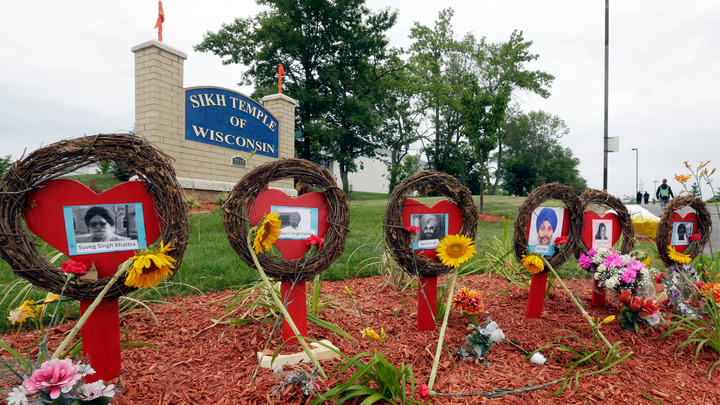Five years after the deadly white supremacist attack on a Sikh temple in Wisconsin, there are troubling signals from the Trump administration that it won’t be taking seriously the threat of violence and terrorism from white supremacists and other domestic extremists.
It was Aug. 5, 2012, when a 40-year-old neo-Nazi walked into the Sikh Temple of Wisconsin in the Milwaukee suburb of Oak Creek and opened fire with a 9 mm handgun, apparently thinking he was attacking Muslims. When Wade Michael Page stopped shooting, six people were dead and four wounded, including the first officer to confront him.
Nearly three years later, on June 17, 2015, white supremacist Dylann Roof, just 21, massacred nine African Americans at the historic Emanuel A.M.E. Church in Charleston in an act of racial terror that shocked the country.
Since then, there have been numerous others killed by domestic extremists, including eight law enforcement officers shot in Dallas and Baton Rouge, Louisiana, in July 2016 by a black separatist sympathizer and a member of an African-American “sovereign citizen” group.
This past May, two men were stabbed to death on a Portland, Oregon, commuter train after they came to the aid of two Muslim women who were being harassed by a man who apparently held racist views.
Six months into the Trump administration, the president has yet to face a domestic terror attack as deadly as those we saw in Oak Creek and Charleston.
History tells us that it’s only a matter of time. But it appears that the administration is taking the threat lightly.
This week, for example, it was reported that the Countering Violent Extremism program within the Department of Homeland Security rescinded a $400,000 grant to an organization called Life After Hate, whose mission is to rehabilitate former neo-Nazis and other domestic extremists.
“We’re dealing with life-and-death issues,” the group’s director, Sammy Rangel, told CNN. “We saw what happened in Portland, the Sikh temple, Dylann Roof.”
Rangel added that the loss of funding sends the wrong message and “might embolden the people we’re trying to help.”
The latest move is not surprising. Last February, Reuters reported that the Trump administration was planning to revamp the Countering Violent Extremism (CVE) program – a three-year-old initiative to counter all violent ideologies – so that it focused solely on Islamist terrorism and not white supremacy. Reuters later reported that President Trump’s proposed 2018 budget eliminates all funding for the program .
White supremacists like neo-Nazi Andrew Anglin – who founded and operates the viciously racist, anti-Semitic website Daily Stormer – are rejoicing. Anglin is an alt-right leader who helped rally the movement behind the Trump campaign. Dylann Roof, who was largely radicalized and indoctrinated into white supremacist ideology online, was among the extremists who posted on Anglin’s site.
“Donald Trump wants to remove us from undue federal scrutiny by removing ‘white supremacists’ from the definition of ‘extremism,’” Anglin wrote. “Yes, this is real life. … Donald Trump is setting us free.”
Last week, in another sign of trouble, the head of the CVE program resigned. Even though it has worked to combat all violent ideologies, the program’s major focus has been building bridges to America’s Muslim communities in an effort to prevent the radicalization of Muslim youth. It has long been viewed with suspicion by anti-Muslim activists, some of whom are now in position to influence the Trump administration.
The Atlantic called George Selim’s resignation a “victory for Trump officials like Steve Bannon and Sebastian Gorka, who see mainstream Muslim organizations as Islamist fronts.” Following Trump’s election, Gorka, a key Trump foreign policy adviser who has ties to anti-Muslim extremist groups, predicted “with absolute certitude, the jettisoning of concepts such as CVE.”
The CVE program is far from perfect. It has been criticized by those on the right and the left, including some Muslim organizations who believe it stigmatizes their communities and has been used as a means of surveillance.
But its apparent demise is emblematic of an administration that is taking its eye off the ball when it comes to combating homegrown extremism, whether from white supremacists or from those who profess allegiance to groups like ISIS.
This neglect comes at a critical moment. The xenophobia of the Trump campaign unleashed a whirlwind of hate across America. We’ve documented a tripling of anti-Muslim hate groups since his campaign began. And, in the first 10 days after the election, we documented nearly 900 bias-rated incidents, including many in which the perpetrator invoked Trump’s name.
It’s only a matter of time until terror strikes again.



